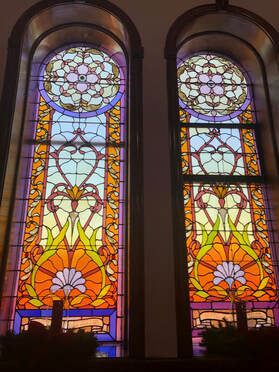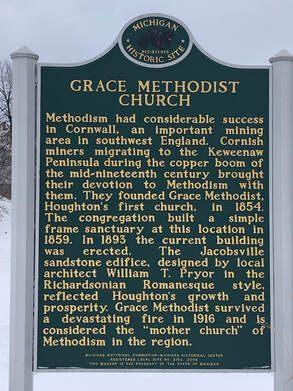If these windows could talk…
|
From the moment these windows were installed in the church back in the 19th century, they became an important part of the lives of the congregation and the community. Their beauty has been part of so many different events and has blessed many people.
Just imagine, worship, weddings, baptisms, funerals, and scores of others celebrations and concerts have all been witnesses by these colorful creations. Wouldn't it be great to hear from the window what they experienced over the years? Here are some stories you may find interesting and entertaining. Project Update: As of October 1st, 2021 Target Amount: $90,000 Total Pledged Amount: $82,812 # of Windows "Adopted": 9 (windows 1, 2, 3, 4, 9, 10, 11, 12 and 17 (as designated on the church schematic found on the Donation page) # of Givers: 52 Project Completed: October 1st, 2021 |
Our stained glass windows are nearly 130 years old. Although the church was founded by several Cornish mining families in 1854, construction of the present Jacobsville sandstone building began in 1888. The new building was dedicated for use in 1893. It was then that the stained glass windows became an integral part of the church.
The first construction of the church was undertaken in the spring of 1859, and the location of the modest shell was on the lot in back of the present church. Upon the appointment of Rev. Robert Bird as pastor in the fall of 1859, he sized up the situation and said to the Official Board, "Brethren, this site will not do for a church; we must have a corner lot." The Board responded that the cost would be "... prohibitive, .... out of range, ....impossible." The new pastor got his way and the corner lot was purchased for .... $250.
The first wooden shell of the church was moved to the new lot in 1859. Construction was completed and the church was dedicated, free of debt, in the winter of 1860. That church faithfully served the congregation for over 29 years. In 1888, however, newly appointed Rev. C. M. Thompson considered the old church 'behind the times' and 'uninviting to the people.' He proposed a new sandstone building which would be both respectable and satisfactory to the people. After much discussion and agonizing over the projected cost, it was decided to erect the new and very elegant church which we now own and use for worship. The elegance, of course, is provided by the combination of Jacobsville Sandstone walls and the beautiful Stained Glass Windows we are now striving to preserve.
For Grace Church everything seemed to be pointing to a very bright future. The new church was completed and dedicated in 1893. The debt on the church was paid off in 1902, and a new parsonage was purchased in 1909. The church was growing and the congregation was indeed blessed. All was well. Then tragedy struck. On the evening of November 24th, 1916, Grace Church was almost completely destroyed by fire. The fire started at 11:00 pm, apparently in the furnace room in the church basement. After two hours of hard work by the Fire Department the fire was brought under control. But ... the fire was not finished. At 2:00 am the fire broke out again and by morning the entire roof had collapsed, the interior woodwork and furniture were destroyed, and the choir loft and pipe organ lay in ruins. All that remained were the massive red sandstone walls and these helped to preserve the beautiful stained glass windows which adorn our church today. Many of these windows were memorials to departed loved ones who help start the church some 60 years earlier.
The calamity of the 1916 fire stunned the congregation momentarily, but only momentarily. That very afternoon the Official Board held a meeting at the parsonage to decide what steps must be taken. In the spirit of true Christianity several neighboring churches immediately offered their help. St. Ignatius Catholic Church offered the use of their large school building for Sunday Services. The Masonic Temple and the Presbyterian Church also offered the use of their facilities. After some months of using the Masonic Temple temporarily, it was decided to accept the invitation of the Presbyterian Church to hold joint services with them and that continued for the next two years.
Shortly after the 1916 fire, there was a strong push by several members of the church board to select another site and build a new church, rather than rebuild the old church. That may have meant the stained glass windows would be sacrificed in the process. However, it literally took a World War to stop that from happening. Indeed, in April, 1917 the U.S. entered World War I and all construction project in the States were deferred until after the war. The new plans for a new church edifice and location were abandoned.
After WWI ended in 1918, the church board decided to partially restore the church building damaged by an earlier fire. This was done by extending the foundation of the building by 15 feet, constructing a new roof and rebuilding the lower floor. Although it was a far cry from the pre-1916 elegant church, the congregation was very grateful and happy to hold worship services, to meet for Sunday School and to have fellowship with one another in their own place, even though in effect it was a glorified basement. For the next 5 years the congregation was content with what they had, but they also knew they could not remain so.
In 1924, under the leadership of Rev. John E. Lewin and with $7,000 in pledges, the Board approved a contract to build a chancel, finish the interior and furnish the auditorium properly. In other words, to complete the church as it was prior to the 1916 fire. Although an additional $7,500 was needed in the end, a grant for this amount was awarded to the church on the condition it would be paid back within five years, which was done. So Grace Methodist Church was back, with the beautiful stained glass windows again gracing the sanctuary as it does today.
|


